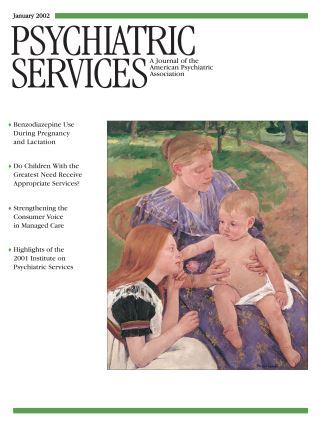To the Editor: The column by Nierman and Lyons in the September 2001 issue (
1) on Illinois' elimination of public inpatient psychiatric services for children and adolescents was apparently intended to provide scientific legitimacy for an essentially political decision to redirect state psychiatric funding away from a small group of very disabled patients and toward a larger, more influential population with less severe impairments. The authors' leading conclusion— "On the basis of anecdotal and empirical data, it appears that the closure of the state hospital for children and adolescents in Chicago was achieved without undue burden on those it served"—is made without any relevant factual support.
The only conceivably relevant empirical data presented in the paper are aggregated scores measuring the severity of symptoms of patients admitted to alternative hospitals that remained in operation after the closure of the long-term public hospitals. Not surprisingly, these short-term inpatient programs reported that their patients were very ill. The authors' argument appears to be that because the short-term hospitals reported admitting very disturbed patients and then discharging them "to family" after brief stays, youngsters who would formerly have entered the state programs are now being adequately treated elsewhere. This is a non sequitur.
The authors provided no follow-up data. Are the acute hospital patients the same people as those discharged from the state programs? How many of the briefly hospitalized former state patients are now in juvenile justice or correctional facilities? How many are successfully attending school? How many are dead? In New York, where Dr. Lyons has prepared reports justifying reduced services to youths, the State Office of Mental Health has actively suppressed the data that would answer these questions.
Nierman and Lyons do not report the anecdotal information that was available to, or used by, the investigators in Illinois, who had no direct clinical responsibility for any of the patients involved. However, I know anecdotally of three cases in New York City in the past year in which state children's psychiatric centers quietly adopted a policy of initiating criminal prosecution of psychotic teenage inpatients to arrange their transfer to correctional facilities, with the explanation that such transfers are a "therapeutic measure" and are not intended to reduce census and justify bed closings.
The transfer of care of mentally ill adolescents from psychiatric to correctional facilities is a growing concern (
2). My colleagues and I have reported that a group of adolescents who were referred for long-term residential treatment but not admitted because of lack of space were 50 percent more likely than those who were admitted to be convicted of a crime as young adults (
3). I believe that this indeed places an "undue burden" on the patients and society.

